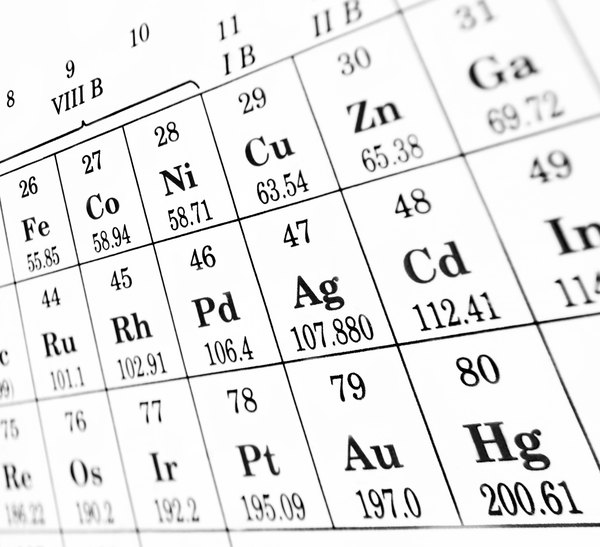how to find valence electrons for transition metals
Electrons orbit around the nucleus of an atom at set free energy levels known as principal energy levels, or electron shells. Each electron crush is composed of i or more subshells. By definition, valence electrons travel in the subshell farthest abroad from the nucleus of the cantlet. Atoms tend to accept or lose electrons if doing and then volition consequence in a total outer shell. Accordingly, valence electrons directly influence how elements behave in a chemic reaction.
Finding Valence Electrons for All Elements Except Transition Metals
Locate the desired element on the periodic table. Each foursquare on the periodic tabular array contains the letter symbol for an element printed straight below the atomic number of the element.
For example, locate the element oxygen on the table. Oxygen is represented by the symbol "O" and has an diminutive number of 8.
Determine the group number and period number of the element. The vertical columns of the periodic table, counting left to right, 1 through eighteen, are called groups. In the periodic table, elements with similar chemical properties are in the same grouping. The horizontal rows of the periodic table, from one to 7, are called periods. Periods represent to the number of electron shells possessed by atoms of the elements in that row.
Oxygen is found in Period 2, Group 16.
Apply the dominion of the periodic table to your element. The rule is equally follows: If an element is non a transition metal, then valence electrons increase in number as you count groups left to right, along a period. Each new menses begins with i valence electron. Exclude groups three through 12. These are transitional metals, which have special circumstances.
Following this rule: Elements in group ane have one valence electron; elements in group ii take 2 valence electrons; elements in group 13 take three valence electrons; elements in group 14 have 4 valence electrons; and so forth upwardly to grouping 18. elements in grouping 18 have eight valence electrons, except for helium, which has merely two.
Oxygen is located in grouping sixteen on the periodic tabular array, so it has half-dozen valence electrons.
Finding Valence Electrons for Transition Metals
-
Electron shells are labeled K, Fifty, M, Due north, O, P, and Q or simply 1 to 7; starting with the crush closest to the nucleus and moving out. Each electron shell can agree a fixed, maximum number of electrons: the K crush holds a maximum of ii electrons, the L beat holds eight electrons, the Grand shell holds eighteen electrons and the N trounce holds a maximum of 30-ii electrons. Theoretically, the O Beat could contain fifty electrons and the P crush could contain seventy-2 electrons, but no naturally occurring element has more thirty-2 electrons in whatever single vanquish.
The maximum number of valence electrons for an cantlet is eight.
At that place are two lines of elements listed beneath the main table on the periodic nautical chart, the lanthanides and actinides. All lanthanides vest in Flow vi, Group 3. Actinides belong in Period 7, Grouping 3. These elements are known every bit inner transition metals.

••• agsandrew/iStock/Getty Images
Be aware of the unique electron configuration of transition metals.
Valence electrons are more often than not what is left over after all the inner subshells of an atom have been filled. Nevertheless, transitional metals may have subshells that are not completely filled. An atom may tend to accept or lose electrons from an incomplete subshell if doing and so volition outcome in a full subshell, so subshell electrons may behave like valence electrons. Past strict definition, virtually transitional metals take two valence electrons, but may accept a larger range of apparent valence electrons.
Locate the transition metal on the periodic table and brand note of the group number. Use iron as an example, a transitional metal with the symbol Fe, atomic number 26 , located at period iv, grouping 8.

••• raeva/iStock/Getty Images
Determine the range of credible valence electrons.past consulting the following table:
Group 3: 3 valence electrons Group 4: 2-4 valence electrons Group v: 2-five valence electrons Group half dozen: 2-6 valence electrons Group vii: 2-7 valence electrons Grouping 8: 2-three valence electrons Group 9: 2-3 valence electrons Grouping 10: 2-three valence electrons Grouping 11: 1-2 valence electrons Group 12: 2 valence electrons
The element iron is in group 8, and therefore has two or 3 apparent valence electrons.
Tips
Source: https://sciencing.com/figure-valence-electrons-periodic-table-5847756.html
Posted by: brownwhipeeir.blogspot.com

0 Response to "how to find valence electrons for transition metals"
Post a Comment